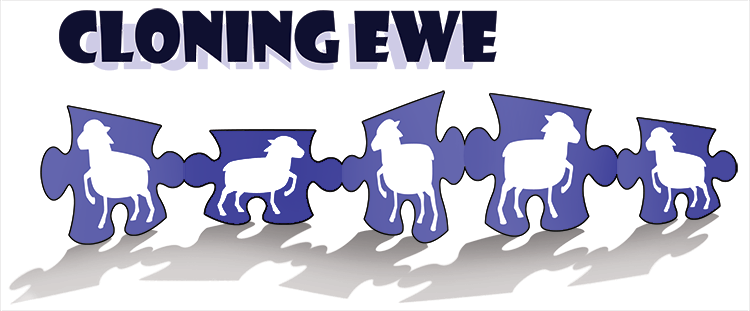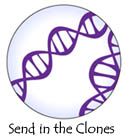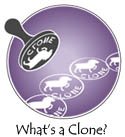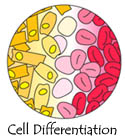
Illustrated by: Sabine Deviche
Introduction to Cloning
Have you ever sat down to do your homework, looked out of the window and said, "There should be two of me. One to stay here and do my homework and one to play out there." Think of the possibilities! What trouble could you get into if there were two of you? How much fun could you have? If only you had your very own clone! Or maybe you do have your very own clone...
 |
 |
 |
We do have clones living among us today. These clones are called identical twins. A clone is an organism, plant or animal that has the exact same genetic blueprint as another organism. If we have clones everywhere around us, what's the big deal about cloning?
Cloning that is covered by the news today is special because we can manipulate cells in such a specific way that we can create clones outside of the body. We are also able to choose which genetic blueprint we want to insert into the cell. The technology came about by studying cells from plants and animals. Scientists discovered what cells require to grow and divide outside the body, what cells need to become specialized cells, and how to use technology to replace the genetic material of a cell.
 |
 |
.jpg) |
The first mammal to be cloned was a sheep named "Dolly." Dolly has the genetic material of a white faced sheep, but her mother was a black faced sheep. Since then, several other animals have been cloned and maybe even some people.
This technology is being used more and more by scientists. Cloning is still not an exact science and we do not really know the overall effects of cloning on the organism's health. These issues create some important ethical questions about how we use this technology today and how we will use it in the future.
Credits: Mannequins image via Bioethics.com. Publised under Creative Commons BY-NC-ND 3.0.
Read more about: Cloning Ewe
Bibliographic details:
- Article: Cloning Ewe
- Author(s): Faye Farmer
- Publisher: Arizona State University School of Life Sciences Ask A Biologist
- Site name: ASU - Ask A Biologist
- Date published:
- Date accessed:
- Link: https://askabiologist.asu.edu/explore/cloning-ewe
APA Style
Faye Farmer. (). Cloning Ewe. ASU - Ask A Biologist. Retrieved from https://askabiologist.asu.edu/explore/cloning-ewe
Chicago Manual of Style
Faye Farmer. "Cloning Ewe". ASU - Ask A Biologist. . https://askabiologist.asu.edu/explore/cloning-ewe
Faye Farmer. "Cloning Ewe". ASU - Ask A Biologist. . ASU - Ask A Biologist, Web. https://askabiologist.asu.edu/explore/cloning-ewe
MLA 2017 Style

Living clones would have identical DNA, and so in most cases would look almost exactly the same.
Be Part of
Ask A Biologist
By volunteering, or simply sending us feedback on the site. Scientists, teachers, writers, illustrators, and translators are all important to the program. If you are interested in helping with the website we have a Volunteers page to get the process started.

